[Folaefolc] was craving a new keyboard build a few weeks ago and got inspired by the humble 3.5″ floppy disk. So much so that he decided to make a split keyboard with each half having the exact footprint of a floppy — 90 mm x 94 mm. And you know the PCBs have floppy details silkscreened on the back. Just check out the gallery.
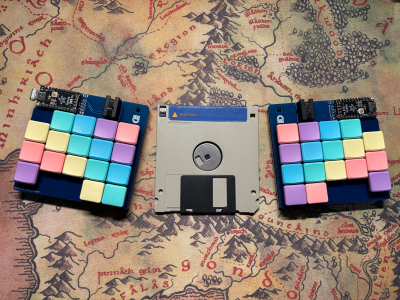
The other fun part of this build is that [Folaefolc] used RJ9 connectors to join the halves instead of something like TRRS.
Beneath those candy keycaps are 34 Kailh choc v1 switches shoved into hot swap sockets in case [Folaefolc] changes his mind. Gerbers are available if you want to build one of these cuties!
Via reddit
A Bicycle Built for Two Hands
[Lachlan Kermode] got so heavy into cycling last summer that he figured out the best possible way to do so while getting work done. Now, if only he could get some fresh air as well.
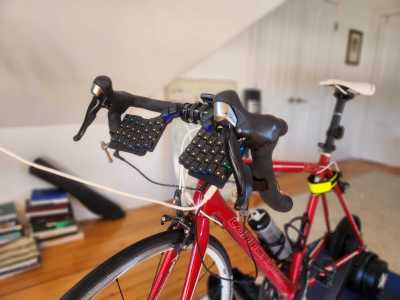
This mount is basically just a couple of magnets that attach to the keyboard halves and let you mount them to a standard tripod screw. A couple of camera clamps later, and Bob became [Lachlan]’s proverbial uncle.
Having used it for a while now, [Lachlan] found the most comfort with the halves pointed downward at a 45° angle, which allows him to rest his palms on the handlebars and type fairly comfortably. It’s going to take some experimentation to get it perfect, but he seems to be most of the way there.
The Centerfold: This 90s Japanese TRON Keyboard
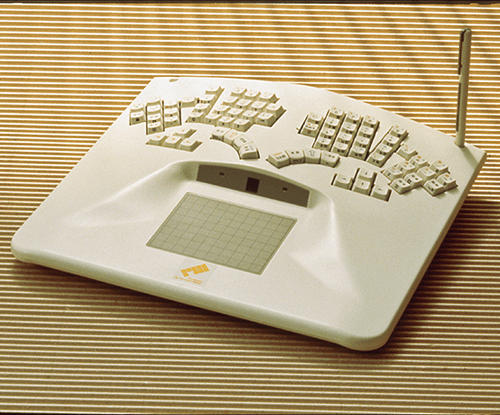
No, not TRON (1982). This keyboard refers to the Japanese operating system and Unicode alternative, where TRON stands for The Real-time Operating system Nucleus. I’m not sure how many fingers you’re supposed to have to use this thing, which looks at once both ergonomic and wildly not, what with those faraway pinkie keys. Hey, at least it’s Dvorak? See also Xah Lee’s page and this video for more about these keyboards.
Do you rock a sweet set of peripherals on a screamin’ desk pad? Send me a picture along with your handle and all the gory details, and you could be featured here!
Historical Clackers: The Fitch (American)
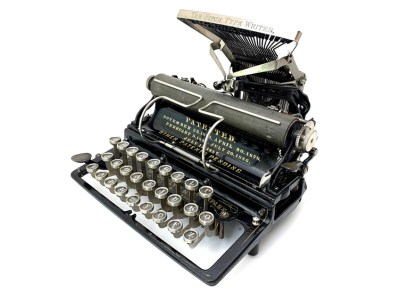
Yes there are British Fitches as well, and they were slightly different than the American Fitch. I’m guessing that both models bore that wild rear-downstrike typebar arrangement which both distinguished it and doomed it to failure. Be sure to check out the other pictures on the Antikey Chop site, including the really strange layout.
The Fitch could type 78 characters with its 26-key, double-shift keyboard. The 1u Space is of particular interest. Ink was transferred via roller, and the earliest specimens had a pair of reservoirs behind the carriage for spare rollers.
Though this machine looks heavy (at least to me), the Fitch weighed only 11 pounds and took up a cubic foot of space. It was never advertised as a portable, though the Antikey Chopkeep theorizes that they could have been. These Fitches were evidently quite well-built little machines, which makes their lightness that much more intriguing.
ICYMI: ESP32 Hosts Keyboard
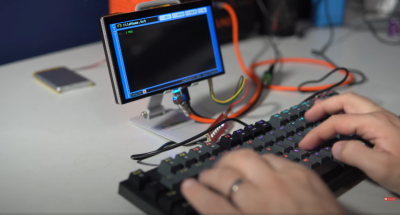
You’re likely aware of the USB device mode of an ESP32. But did you know that they can act as HID hosts, too? That’s Human Interface Devices — keyboards, mice, trackballs, and the like.
For this project, [Volos] used the EspUsbHost Arduino library, which makes USB host mode a relatively simple thing to use. Tantamount to success here is the LCD board: it has a dual-role USB-C port, so the hardware required to switch roles is right there.
On the software side, [Volos] created a simple word processing program that saves and loads files from a microSD card, using a four-bit palette to save on memory.
Got a hot tip that has like, anything to do with keyboards? Help me out by sending in a link or two. Don’t want all the Hackaday scribes to see it? Feel free to email me directly.

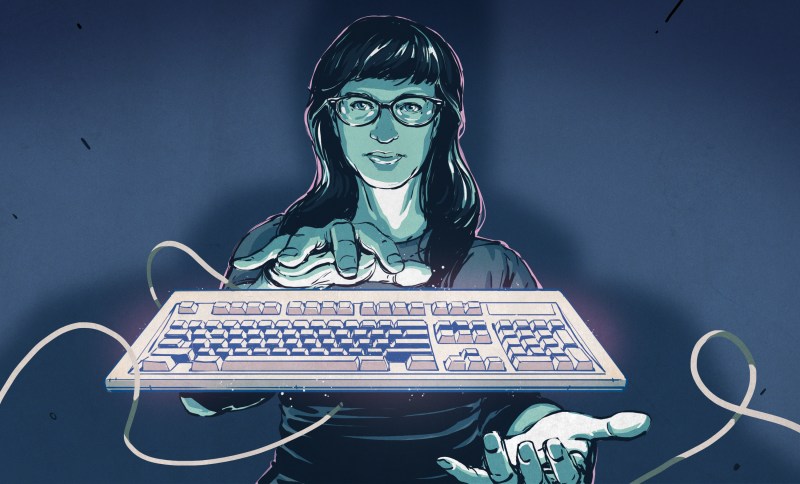














The bicycle handlebar keyboard is a new plateau of workaholism. I love it. And up there next to the keyboard trousers for cyberpunk aesthetic
There was a guy with a recumbent bicycle a long time ago (80s?). He did 2 sets of buttons but memorized the ASCII (?) codes and chorded them in a bit at a time XD
Steve Roberts. See my comment below, posted 4 minutes before you posted yours.
The Liatris microcontrollers do use RP2040 chips. So that is a trifle inaccurate.
They try their best to hide it, it seems.
But when I saw it can run Micropython I was just 100% sure it was not a new microcontroller but some existing one … already supporting Micropython.
So it´s a 18€ RP2040 board with almost nothing special (expect of course the price and the marketing). It looks like it´s enough to make a fat profit out of gullible clackafandom.
If you read the specs of the Liatris, it is a very clever design to bridge old and new. It also has a ton of flash memory. And it is less than €15 before sales tax.
Given the investment space custom keyboards operate in: even two of those on a split keyboard are a neglectable cost.
I don’t think that’s how you use the word “tantamount”.
It’s probably Steve Roberts that should be credited with the original bicycle handlebar keyboard.
https://microship.com/behemoth-computer-history-museum/
Typing in straight ASCII (with chord shortcuts). Made from eight keys of the type used in Fedex handheld terminals of the era, IIRC. Jeez, that was a long time ago.
I saw him and Winnebiko at CES in 1989?
That would have been the very end of the Winnebiko era. He started using BEHEMOTH around then.
The Helmet of the Behemoth looks familiar. did they use that in honey I shrunk the kids?
Old DOS trick to turn a $2,000 IBM XT into a dumb typewriter: type con > lpt
Every key press goes straight to the printer. No spell checking, no typo correction, no neat formatting. Just like 1800 typewriters.
That TRON keyboard seems like it is a very ergonomic concept that like so many keyboards in the past has found its too hard to go without extra dedicated keys for other tasks sometimes – for instance the numpad is hell to go without to the folks that actually really use it, so anybody with a numbers heavy job will really hate your keyboard if it lacks one (though with how few devices have shipped with one in recent decades might be a blip in the population that would have learned but couldn’t).
Yeah, I keep a USB numpad in my backpack, just in case…
I used to have a USB mouse that was slightly oversized because it had a number pad on its back. It was great for laptops. Unfortunately it died after many years of service and I’ve never found another one like it.